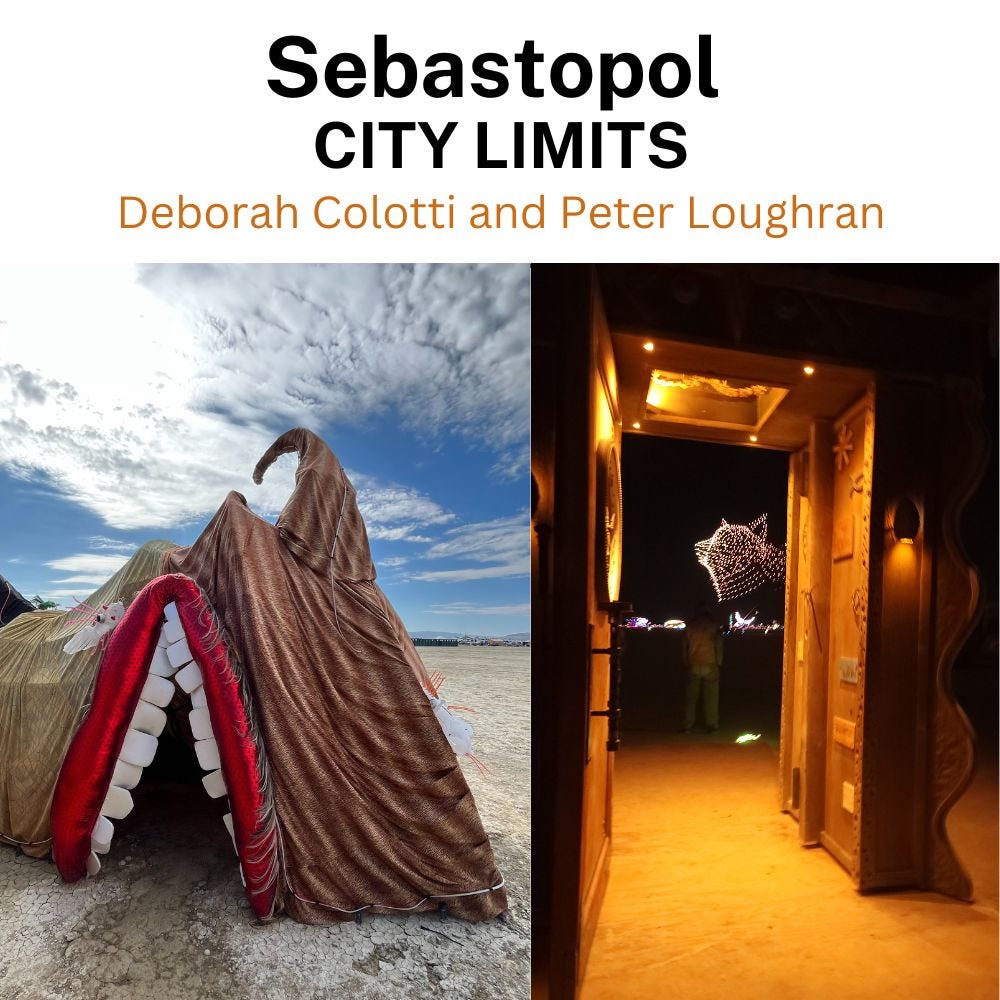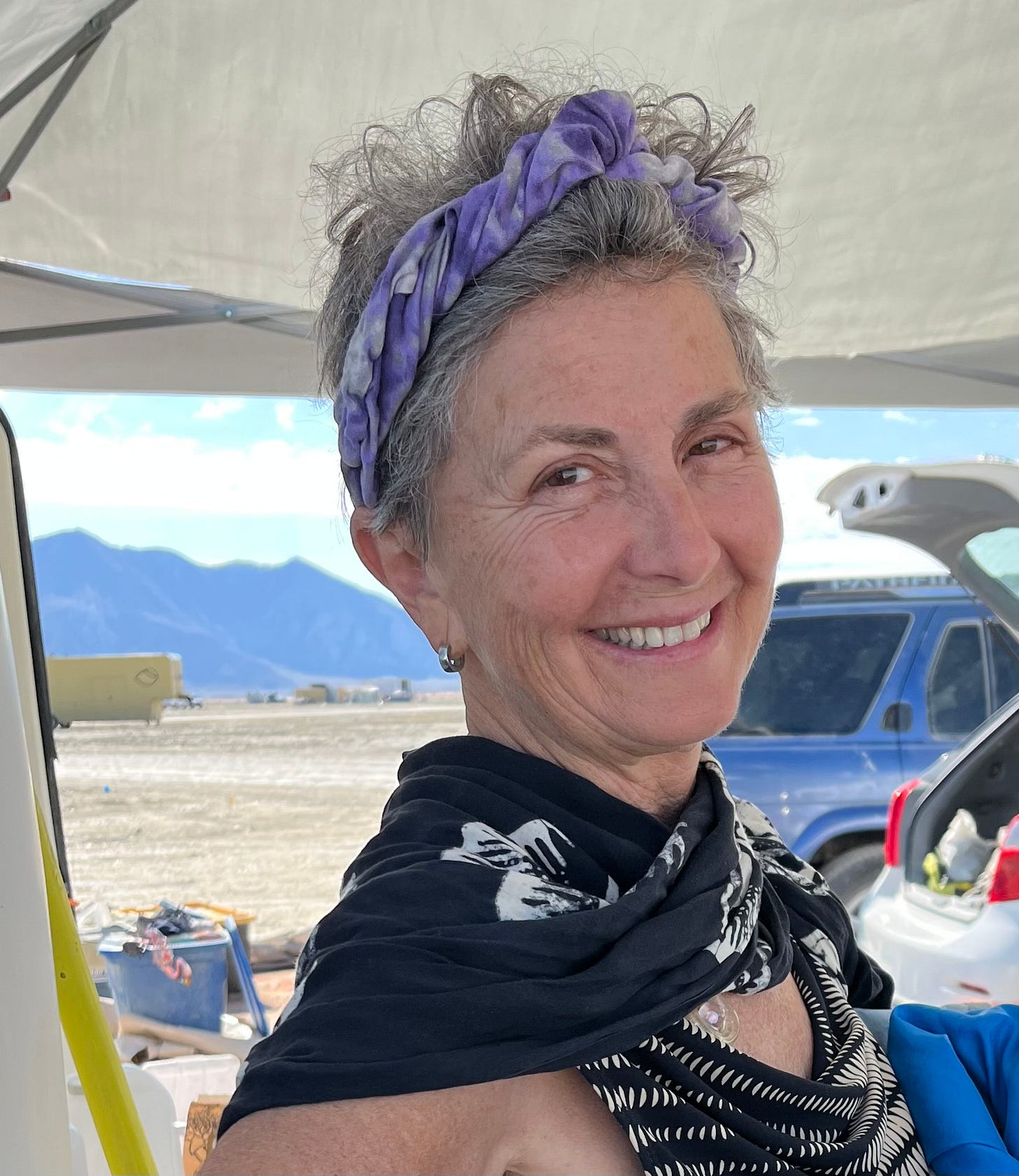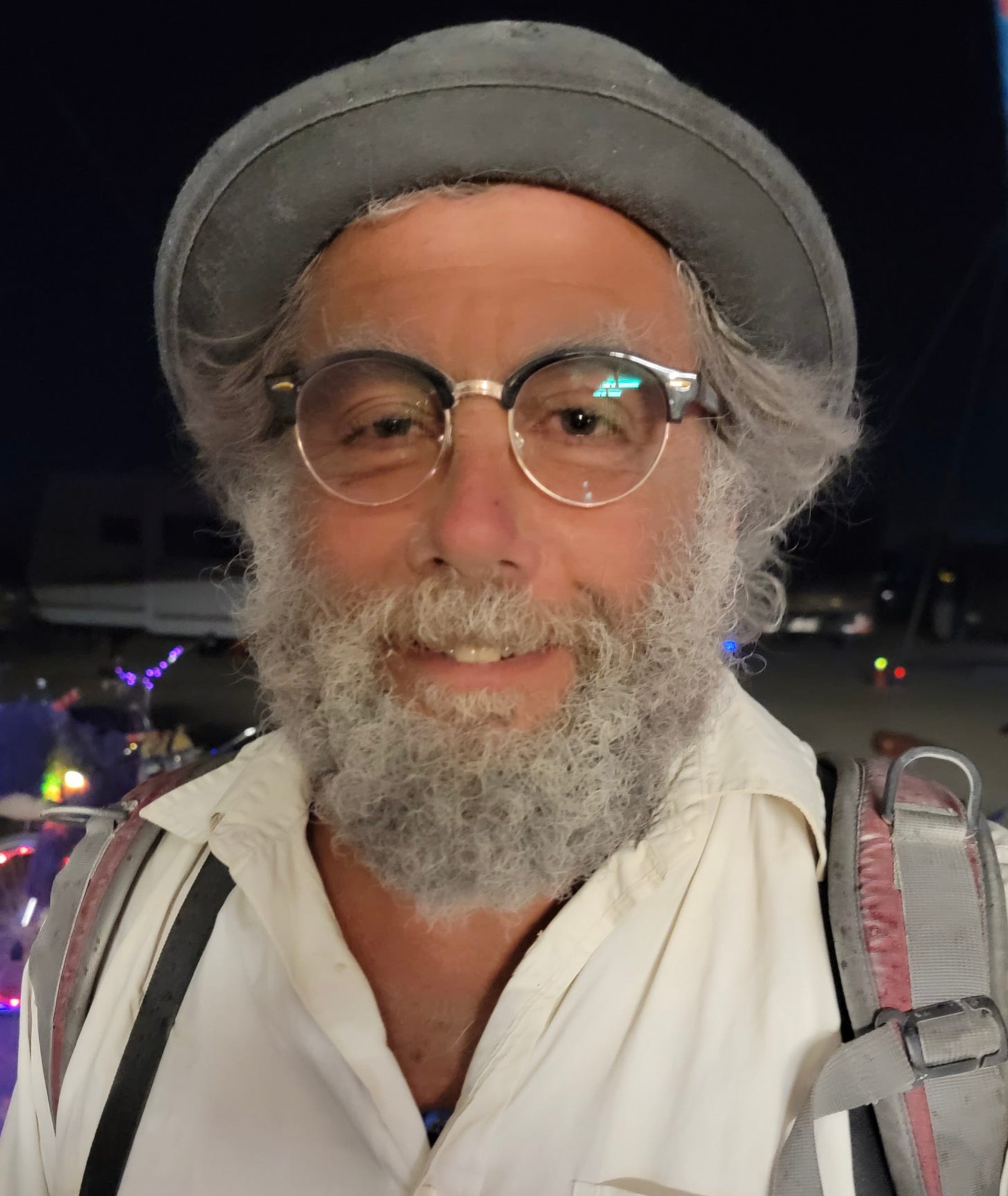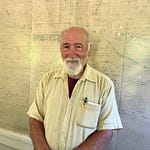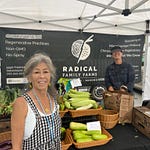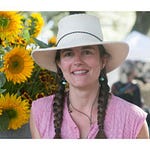Burning Man, the desert festival of radical inclusion, is also an amazing art festival by day and by night. My guests on this episode are two local art-makers, Deborah Colotti and Peter Loughran, who brought their own art to Burning Man this year. They returned home last week in good spirits after two weeks on the Playa. Both of them have been going to Burning Man for many years, and they are used to its harsh conditions and unpredictable weather. Moreover, they find the beauty in the whole experience - being there is part of the art of Burning Man, too.
Deborah Colotti’s “Shit$torm”


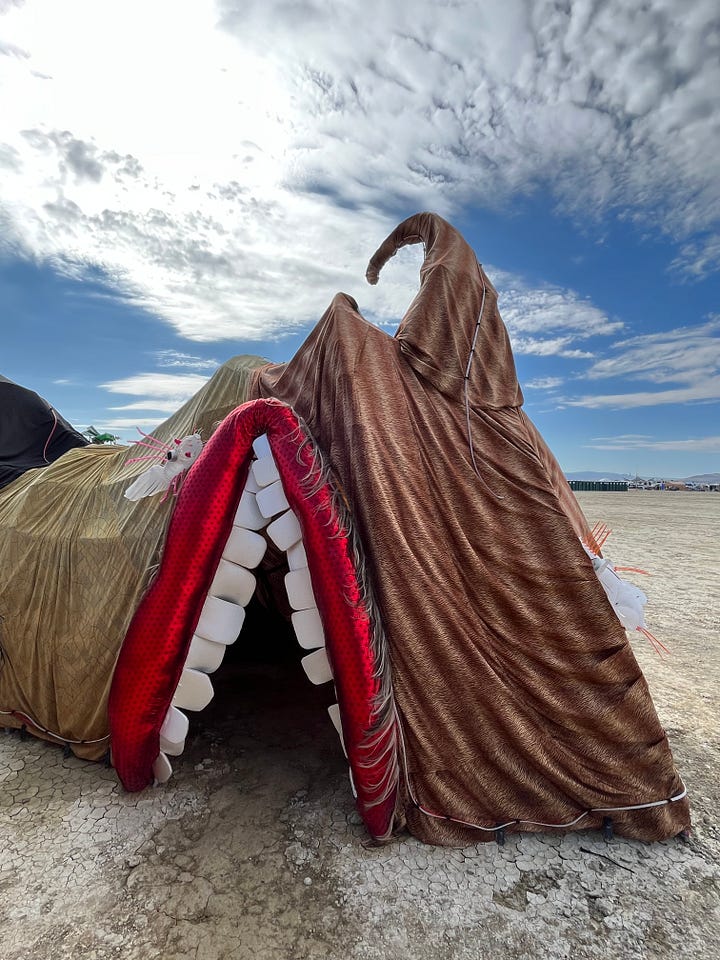

Artist website: www.dcolotti.com
Peter Loughran’s The Door to Everything

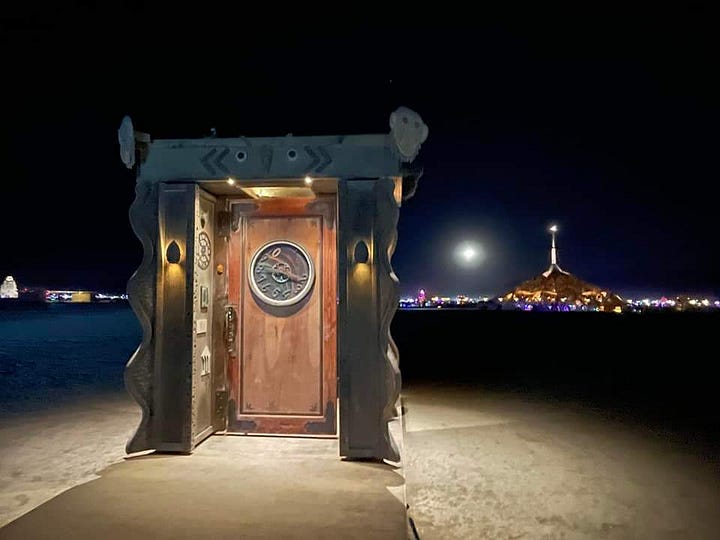
Transcript
My guests today are Debra Colotti and Peter Loughran, both Sebastopol artists who recently returned from Burning Man.
Deborah, just introduce yourself and tell us a little bit about what you do and your art.
Deborah: My name is Deborah Colotti. I've been in Sonoma County since 1980. I've been traveling around the world studying art in India and Japan and Austria, and I settled in Sonoma County because Sonoma State had this wonderful art department, and I've been making sculpture. That's my primary medium. And I work a lot with textiles. For Burning Man, I've been trying to make really big things that collapse into really small trailers. I don't rent any big trucks or equipment and my own private work that's not for Burning Man, I work much smaller and fine details but I'm interested in social, cultural issues in particular so that my work usually touches on those topics.
Dale: And my other guest is Peter Loughran. Peter, tell us about yourself.
Peter: Yeah. Hi, my name is Peter Loughran and I am a general building contractor in Sonoma County for the better part of the last, oh, 12 years and Northern California for about the last 40 years.
I lived out on the coast for a number of years, etc. I've been to Burning Man-- let's see, 18 times. My first year being 1995. I have consistently been involved in projects or spearheaded projects pretty much every burn that I've been to and have provided various different art pieces over the years.
Dale: Debra, going back to you, was this the first piece you brought to Burning Man?
Deborah: No. I first went in 2008. To check it out, I went by myself and didn't join a camp, didn't know all the layout of Burning Man, but I went there, I saw the conditions, I went home and started my first art piece.
I think this is my 10th or 11th art installation and then sometimes I build for two years and I take a year off and just go to enjoy and not have the responsibility of maintaining an artwork. Because it is a lot of work.
Dale: Can you describe your piece that you built for this year?
Deborah: So this year I brought a piece called Shit$torm and the second "S" in shit,
Dale: it's appropriate.
Deborah: Yes. The second “S” in “Shit$torm” is a dollar sign. And so I made one tunnel that was 90 feet long shaped in the US dollar sign, but it was a giant turd. And you walked, you walked into the mouth, went through the esophagus, the stomach, and crawled out an elasticized anus.
In the stomach area, I took 200 table napkins and wrote vocabulary, history, all related to digestion, ways to say "bowel movement," which turns out there's many in English and stuff about microplastics and the environment, and so it had many layers of fun and seriousness. And it all fits in a little tiny garden trailer.
Dale: Wow. So how long did it take you to set it up once you got there?
Deborah: Oh, too long. My crew every year tells me to get simpler.
Dale: Peter, what did you propose this year? And was it your first build? It sounds like you've been there a number of times. So you've been a part of other builds.
Peter: Oh, no. I've either been the lead or I've also, I brought my own pieces. In the 90s, I built a giant theme camp on the Esplanade and was involved in several art pieces in conjunction with what I was doing personally. And more recently I built a piece in 2019 called the "Stairway to Nothing."
And then last year I was asked to be the lead on a piece that was called Unbound, a library in transition, which was also a very interesting piece to be involved with. And then this year I wasn't originally intending to work on a theme, but it developed into a theme. And this year I brought "The Doorway to Everything."
It was a smaller piece and it was thought provoking and very interesting and I'm getting a lot of feedback that I pulled that off.
Dale: What does it look like?
Peter: It's too bad I can't just flash you a picture right now. But nevertheless, it was a door, the actual door itself was eight feet tall by four feet wide and it was wrapped in looked like these large cubes. I don't know how to, how else to say it. And I built it in such a manner that it appeared as though nothing was really connected to one another.
And so it had kind of these spaces. I don't know how to say it, but it it was called “The Doorway to Everything.” It was a collaboration of many of my different friends. And I basically themed each area.
The theme (of Burning Man) this year was Animalia, so there were animals and nature on the exterior, and then as you approached it, one side of the door was themed space; the other side was themed time and then above was themed love, and each one of my friends took on each of those themes and did a piece for it.
And then on each side of the door as you walk through, was loosely themed science and religion, but it also had music and some poetry and some other elements to it as well.
Dale: Both of you, you don't know each other from Sebastopol, did you see each other's art there? Did you happen to run into Shit$torm, Peter, or Deborah, did you run into "the Door to Everything"?
Deborah: Maybe if I saw a picture, I would recognize it.
Peter: I really wish that I would have run into Deborah's piece. It sounds if not humorous, very very interesting.
Dale: What did you see people doing with your piece? What, any surprises, Deborah?
Deborah: Surprises. I had all these table napkins with text, books and sayings and so there was a lot. It took safety pins and your fingers get numb after a while out there on the playa.
I would enlist people who came in to the structure to, hey, could you help me for five minutes? Could you hang this napkin up? And some people stayed. They hang one, and some people stayed for an hour and hung many. Because it was a shelter, it had a roof and walls, people often escaped in there, whether it was for the dust, the wind, the rain.
Because I was there handing out these napkins to be installed, I had great interactions with people. And, my piece has a lot of humor. But that was great. I love that.
Dale: Peter, did you have any surprising interactions with people?
Peter: Surprising is a good word, but it was more about gratifying.
There were a lot of reactions. A common artist experience is not knowing if anybody's going to like your piece at times. And so it was really, it was really gratifying to see people gaining different elements from it. As I said, there were all these different elements in my piece.
I hope that there would be something interesting to everyone, right? There would be this or that little thing that rang a bell in some form or another. I would say that the most satisfying thing that occurred on the playa was after the rains, I hadn't been able to light the piece for two days. After the rains, before the man burn, we went out and we lit the piece. This couple rode up on one-wheels and they came up to me and they said, “this piece moved us so much that we decided to get married here.”
They got married on the piece and that was, obviously, very gratifying because it meant that much to somebody.
Dale: That's a wonderful story.
It was an unusual year at Burning Man. I didn't go, but I read the reports and everything. How did each of you do during the rain and the experience of Burning Man? Did it feel at least up until those points did it feel like a regular Burning Man and then then you had some challenges?
Deborah: Last year was rough. It was hot, it was dusty, it was extreme. Half my crew left either ill or something, dehydrated or injured. So this year was quite mild. It was mid 80s, low 90s to start and a little rain. And then the rain came. I loved it. It changed the whole tempo of the event because instead of people riding their bicycles off to a party a mile away, you stayed in place, you hung more with your neighbors, there was time to read and catch up on things. And so I didn't venture off my mats or my flooring outside for a day and a half.
And then it was fine to walk, and we all had food, we all had water, there was no panic. We got it together. It was great. I loved it. After the rain, everything was cleaned, all my fabrics, all my piece were cleaned, and it was washed, and I came home with the least dust ever.
Peter: I second everything that Deborah said. Things were clean and went like in ways that you never experienced. The other thing was that for me a great deal of part of my experience is about the extremes. So last year while it was extremely uncomfortable, dusty, hot, and all of that, I felt a lot of camaraderie with my crew, having built a rather large piece through all of that and everything.
So that was part of my inspiration. It seems each year there's something that inspires me to come back the next year. And that was the same for the rain. It tested everybody's limits and in my world, almost everybody stood up to it and, just made the best out of the circumstances.
I think I'm mirroring what Deborah said in that people got an opportunity to get a lot more intimate with people because we were locked down. And we were able to develop friendships in a way that we probably wouldn't have if we'd have all been riding off on our bikes and marauding around town or whatever.
From my experience, it was a value-add. The other part of that is that certainly if it had gone on for another two or three days, it might have gotten awful. But nevertheless, we had plenty of food. We had great dinners together and really just enjoyed one another's company.
Dale: That doesn't always come out in the press coverage, does it? And that's what I wanted to talk to you about, because I think it's, the art is just amazing there. And it's such a special location. And when you see all the lights and things going on at night, it really is beautiful.
Any other pieces of art or things that you saw that you can describe, or that you enjoyed?
Deborah: On Friday before the rains were announced, the rains were announced, we knew it was coming. And I just had to go out and see the 30-foot clitoris.
It was so well done. The wind kicked up, the dust kicked up. I was hiding behind one of the legs of the clitoris with two rangers having great talks about such things. It made me wonder what city would have the nerve or the balls to install that in their city center because it was built for the public. It's amazing construction, beautifully done with a lot of information. I was just, wow. Wow.
Peter: The interesting thing is that of all the pieces and there were a lot of magical ones, I would have to say that particular piece, and I was going to bring it up as well, stirred up more amazing conversations and and whatnot in our camp than any other piece out there in particular.
That piece was at first, from my perspective, it's okay, what the hell is that? Wait, why does it look, what the heck are they trying to do? What kind of goofy thing is that? And then once you read it and you learn what it is, you're like, oh wait a minute.
So no, that was definitely a very, conversation-provoking piece. It was great.
Dale: I guess maybe the last question is -- did you get home, okay?
Deborah: They postponed Burning the Man from Saturday to Monday, and then they burnt the Tower of Babel Monday night because thematically they had a more resonance than the temple on Tuesday. So I took my artwork down Tuesday afternoon, packed that into the truck just in time to walk over and see the the temple burn.
That was amazing. I drove off the playa on Wednesday and then stayed a night in Sparks and then drove home on Thursday. That was all very easy. I didn't have any commitments.
Dale: How many days were you on the playa?
Deborah: Two weeks.
Dale: That's a lot.
Deborah: it's normal for me.
Peter: Me too. Same.
Dale: How was your getting out, Peter?
Peter: So almost exactly the same as Debra is saying. I have a construction company that's very busy, but I have the infrastructure to be able to direct some things, make sure that everybody got taken care of.
I wasn't planning to leave before Tuesday anyways. So getting out of there one day later wasn't really that big of a deal. We did drive all the way home. But, same as Deborah, we took our piece down on Tuesday. My piece was placed — I've never seen a piece placed this close to the temple before, and quite literally would have been like it was right on the perimeter of where the people would have been sitting. So it would have been, it would have been fun to have left it up and climb up on top of it or something for the temple burn. But we got it out of there a little bit earlier in the day and had a wonderful temple burn.
And then the morning, my shipper showed up. He had actually come up to come to Burning Man like hours before the rain and he had gotten turned away. So he had come back home and he came up Tuesday night. Wednesday morning, we hooked him up on the trailer and we caravaned all the way home.
Dale: Are you going back next year?
Deborah: Of course!
Peter: I'm inspired to build something. I'm not exactly sure. We had a lot of newbies in our world this year and watching them become inspired is another part of Burning Man that I really enjoy. There's a thing in the org of make no commitments until January. I won't say that I will for sure be there next year, but it's pretty likely that I will for sure be there next year.
Dale: Thank you both of you for taking time to tell me about your experiences and your art. I'm glad to learn more about that and thank you very much for joining me today.



